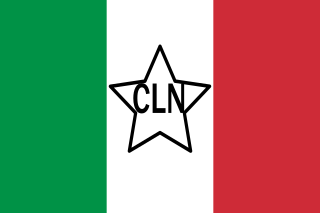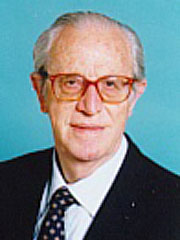Related Research Articles

The Italian resistance movement is an umbrella term for the Italian resistance groups who fought the occupying forces of Nazi Germany and the fascist collaborationists of the Italian Social Republic during the final phase of the Second World War (1943–1945). As an anti-fascist organisation, La Resistenza opposed Nazi Germany and the Italian Social Republic (1943–1945) puppet state created by Benito Mussolini after Hitler ordered the military occupation of Italy by the Wehrmacht and the Waffen-SS, from September 1943 until April 1945.

Pietro Sandro Nenni was an Italian socialist politician, the national secretary of the Italian Socialist Party (PSI) and lifetime Senator since 1970. He was a recipient of the Stalin Peace Prize in 1951. He was one of the founders of the Italian Republic and a central figure of the Italian left from the 1920s to the 1960s.

The Arditi del Popolo was an Italian militant anti-fascist group founded at the end of June 1921 to resist the rise of Benito Mussolini's National Fascist Party and the violence of the Blackshirts (squadristi) paramilitaries. It grouped revolutionary trade-unionists, socialists, communists, anarchists, republicans, anti-capitalists, as well as some former military officers, and was co-founded by Mingrino, Argo Secondari and Gino Lucetti – who tried to assassinate Mussolini on 11 September 1926 – the deputy Guido Picelli and others. The Arditi del Popolo were an offshoot of the Arditi elite troops, who had previously occupied Fiume in 1919 behind the poet Gabriele d'Annunzio, who proclaimed the Italian Regency of Carnaro. Those who split to form the Arditi del Popolo were close to the anarchist Argo Secondari and were supported by Mario Carli. The formazioni di difesa proletaria later merged with them. The Arditi gathered approximately 20,000 members in summer 1921.
Tigrino Sabatini, was a communist and a leader of the Italian Resistance, executed for his activities as a zone-commander of the Movimento Comunista d'Italia, also known as Bandiera Rossa.
The Movimento Comunista d'Italia (MCd'I), best-known after its newspaper Bandiera Rossa, was a revolutionary partisan brigade, and the largest single formation of the 1943-44 Italian Resistance in Rome.

Anna Maria Enriques Agnoletti was an Italian partisan, shot by the Nazis on 12 June 1944. For her actions in support of the Italian partisan movement she was honored post-mortem with the Gold Medal of Military Valour.

Adriano Ossicini was an Italian partisan, politician, academic, and Minister for Family and Social Solidarity in the Dini Cabinet.

Luigi Pintor was an Italian left-wing politician and journalist.
Agostino Casali known as Tino was an Italian politician and partisan, President of National Association of Italian Partisans from 2006 to 2009.

Luciano Lama was an Italian trade unionist and politician, General Secretary of Italian General Confederation of Labour from 1970 to 1986.
The Italian partisan brigades were armed formations involved in the Italian resistance during the World War II.

The Brigate Garibaldi or Garibaldi Brigades were partisan units aligned with the Italian Communist Party active in the armed resistance against both German and Italian fascist forces during World War II.

The history of women in the Italian Resistance plays a key role for the partisan movement in the fight against Nazifascism. They fought to regain their country's freedom and justice by holding functions of primary importance.
The Women's Defense Groups were a women's support organization active during the Italian Resistance. The groups were created in Milan in November 1943, on the initiative of the Italian Communist Party. The full original name of the groups was "Women's Defense Groups for Assistance to Freedom Fighters".

Maddalena Cerasuolo, also known as Lenuccia, was an Italian patriot and antifascist partisan.

Pietro Amendola was a communist Italian politician and journalist, who served in the Chamber of Deputies from 1948 until 1968. A war hero, and anti-fascist partisan, his father was Giovanni Amendola, a noted anti-fascist in the 1920s, and his brother, Giorgio, was also a communist politician.
Giovanni Frignani was an Italian soldier and Resistance member, most notable for his role in the arrest of Benito Mussolini after his dismissal as Prime Minister of Italy on 25 July 1943, in the arrest and death of Ettore Muti, and in the Roman Resistance after the Armistice of Cassibile.
Gian Paolo Gamerra was an Italian officer during World War II, posthumously awarded the Gold Medal of Military Valor.
Sabato Martelli Castaldi was an Italian Air Force general and a member of the Italian Resistance during World War II.

Giuliana Nenni (1911–2002) was an Italian journalist and politician. She served in the Italian Parliament and Senate for the Italian Socialist Party. She was known as the sister of all Romagna’s women.
References
- ↑ Corvisieri, Silverio (1968). Bandiera rossa nella resistenza romana. Rome: Samona e Savelli.
- ↑ "Donne e Uomini della Resistenza: Tigrino Sabatini". www.anpi.it. Retrieved 2015-10-02.
- ↑ Antonini, Silvio. "La storia di Bandiera Rossa nella Resistenza romana" (PDF).
- ↑ "Donne e Uomini della Resistenza: Anna Maria Enriques Agnoletti". www.anpi.it. Retrieved 2015-10-02.
- ↑ Broder, David (March 2015). "I partigiani che volevano fare la rivoluzione". Micromega.